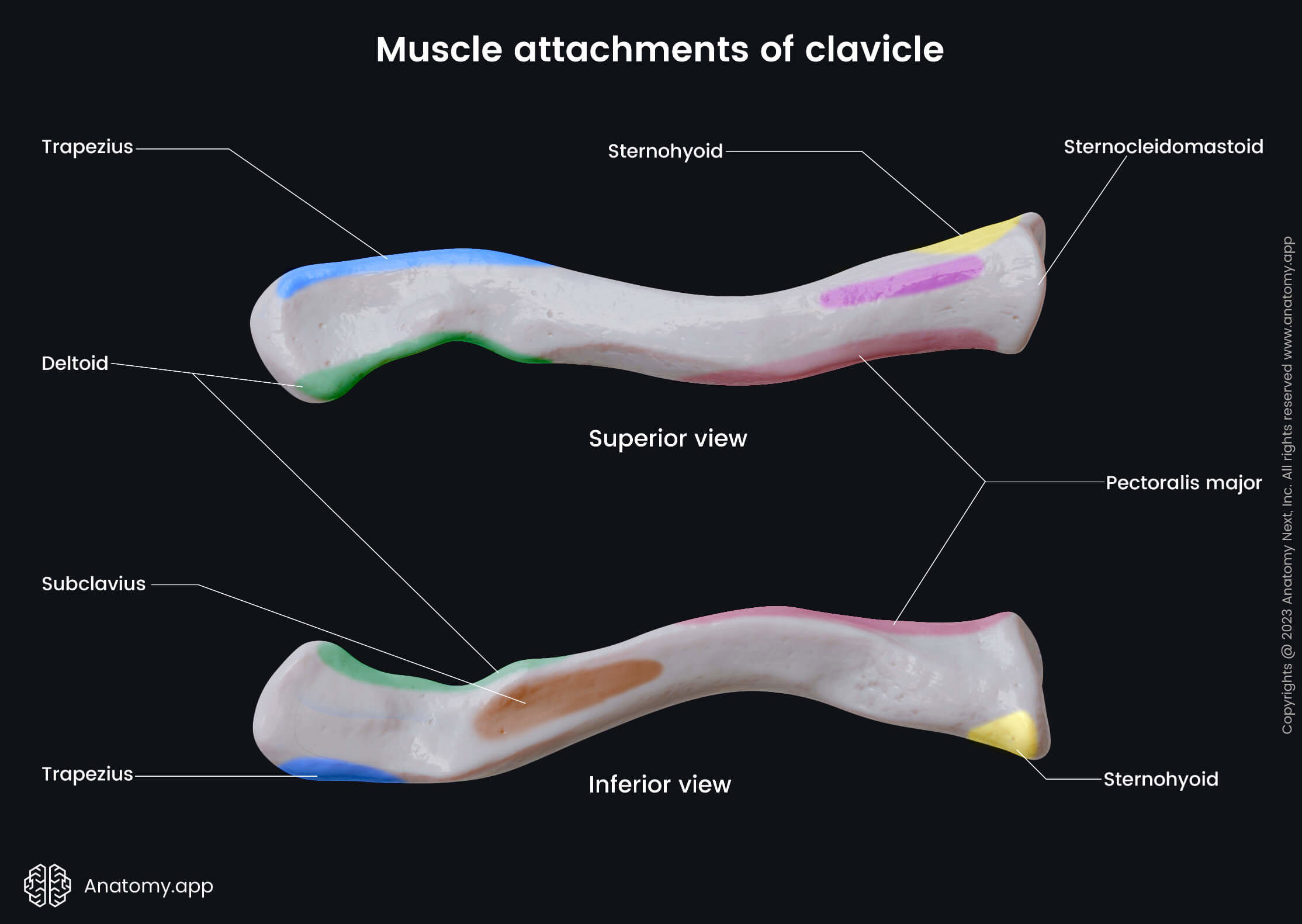Clavicle
The clavicle, also known as the collarbone, is a slender, somewhat s-shaped long bone that participates in forming the shoulder girdle. It has two curves that give the bone its shape. When facing forward, its medial portion appears convex, while its lateral aspect is concave. In cross-section, the clavicle appears oval-to-circular.
The clavicle is situated directly above the first rib. Interestingly, the clavicle is the only bone that connects the upper limb to the rest of the skeleton. It happens at the sternoclavicular joint. Additionally, the clavicle is also the only long bone that lies horizontally in the human body. It acts as a strut that keeps the scapula in place so the upper limb can hang freely.
The clavicle not only attaches the upper limb to the trunk but also protects neurovascular structures that go underneath it and supply the upper limb. Moreover, it transmits the force from the upper limb to the axial skeleton.
The clavicle can be subdivided into the following three parts:
- Sternal end - rounded medial end of the clavicle; it appears more massive than the lateral end and is flared like a trumpet; it is easily palpable along its length;
- Body or shaft - refers to the middle part of any long bone;
- Acromial end - superoinferiorly flattened, broad lateral end.
Landmarks
The clavicle has two well-distinguishing surfaces - superior surface and inferior surface. Both have several important landmarks, and they also serve as attachment sites for various structures. Overall, the superior surface is smoother and has less relief than the inferior surface.
The medial end of the clavicle articulates with the manubrium of the sternum, forming the sternoclavicular joint. Therefore, the sternal end of the clavicle has a relatively large surface for articulation with the clavicular notch of the manubrium, and it is called the sternal articular facet.
In contrast, the lateral end of the clavicle articulates with the scapula, forming the acromioclavicular joint. This end articulates with the acromion of the scapula, and therefore it has an acromial articular facet. The area surrounding the joint gives attachment to a fibrous joint capsule.
The clavicle serves as the attachment site for several muscles and ligaments, including the deltoid muscle (its clavicular part). It attaches to the anterolateral aspect of the bone. Additionally, the anterosuperior aspect of the acromial end presents a small rounded protuberance that also serves as the attachment site for the deltoid muscle and is known as the deltoid tubercle.

Besides the deltoid, the trapezius muscle, sternocleidomastoid muscle, pectoralis major muscle, and sternohyoid muscle also attach to the clavicle. The trapezius connects with the clavicle at the opposite side of the attachment of the deltoid muscle - at its posterolateral aspect. The clavicular head of the sternocleidomastoid originates from the posteromedial aspect of the clavicle, while the clavicular part of the pectoralis major muscle arises from the anteromedial aspect of the bone. And finally, a small portion of the sternohyoid muscle is attached to the sternal end of the clavicle.
The inferior surface of the midshaft presents a shallow groove called the subclavian sulcus. It is found more on the posterior aspect of the mentioned surface and serves as a bony roof for the great vessels that pass under the clavicle. Additionally, it also serves as the attachment site for the subclavius muscle that stretches between the first rib and the clavicle.
The inferior surface is marked by one more landmark. The sternal end presents a rough, broad, oval-shaped area that anchors the costoclavicular ligament, which strengthens the sternoclavicular joint and stretches between the first rib and the clavicle. This landmark is known as the impression for the costoclavicular ligament. Some authors prefer to use the terms costal impression or costal tuberosity to describe this anatomical feature.
The acromial end of the clavicle also has several important landmarks. Almost opposite to the deltoid tubercle is one more round protuberance called the conoid tubercle. It is found on the posterior aspect of the inferior surface, and it serves as the attachment site for the conoid ligament. The conoid ligament is the medial part of the coracoclavicular ligament, and it connects the coracoid process of the scapula to the clavicle.
Lateral to the conoid tubercle is an oblique ridge known as the trapezoid line. It is an attachment site for the trapezoid ligament, which is the lateral portion of the coracoclavicular ligament.